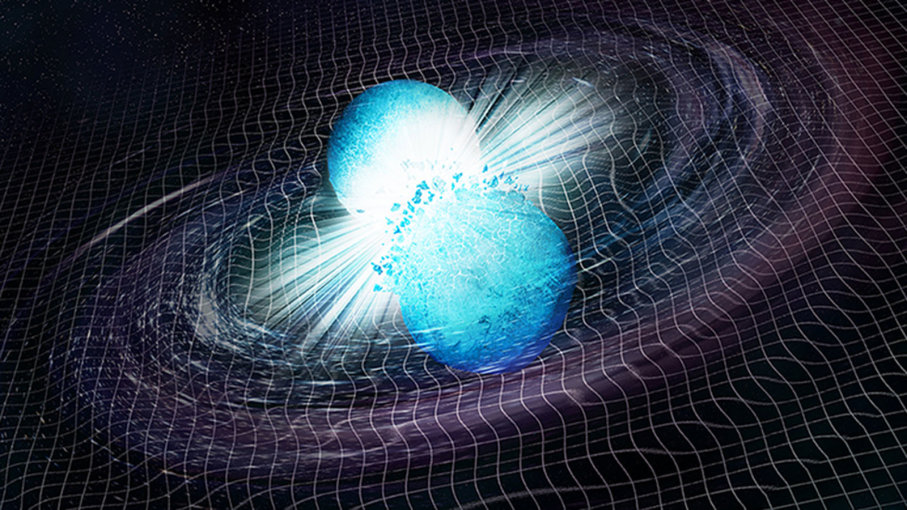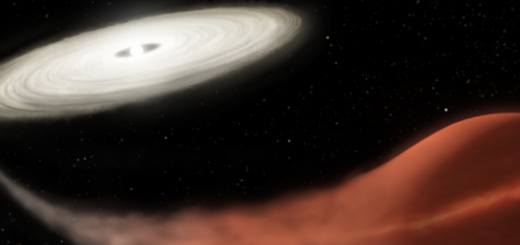What Do You Get When Two Neutron Stars Collide?

When two neutron stars collide and merge, what do you get? A beefier neutron star or a tiny black hole? A May 2018 paper looking into last year’s historic neutron star collision suggests the latter.
On Aug. 17, 2017, the U.S.-based Laser Interferometer Gravitational-wave Observatory (LIGO) and Italian Virgo gravitational wave observatory detected what is arguably the most significant astronomical event in modern times: a neutron star smashup. That smashup created a gravitational wave signal named GW170817. Unlike the handful of gravitational wave signals that came before it, GW170817 wasn’t generated by a merging black hole.
Three gravitational wave observatories (the two LIGO stations in Washington and Louisiana, plus the single Virgo detector) detected the signal in concert, so scientists were able to triangulate the approximate location in the sky where the gravitational wave signal came from. Then, at roughly the same time, NASA’s Fermi space telescope detected a short gamma-ray burst (GRB) in that patch of sky. Scientists had theorized that such bursts were triggered by two neutron stars colliding, and through the analysis of GW170817, they confirmed the neutron star merger scenario.
Astronomers made many scientific discoveries in the wake of this astronomical event, but GW170817 just keeps on giving. With the help of NASA’s Chandra space telescope, which continued to study the site of the neutron star merger in the days, weeks and months afterward, astronomers now think that the neutron star merger birthed a baby black hole. And we’ve never seen that before.
From the LIGO studies, astronomers already had a pretty good idea as to the mass of the colliding neutron stars and the mass of the object that they ought to produce post-collision. By their estimates, the merged object would have a mass of around 2.7 times that of our sun. This is an interesting mass as it’s right on the edge of either being the most massive neutron star or the lowest mass black hole ever discovered. To work out whether the event created a monster neutron star or a tiny black hole, astronomers needed to study the X-rays being generated, and that’s where Chandra helped out.
“While neutron stars and black holes are mysterious, we have studied many of them throughout the Universe using telescopes like Chandra,” said Dave Pooley of Trinity University in San Antonio, Texas, who led the study. “That means we have both data and theories on how we expect such objects to behave in X-rays.”
Guinness Might Be Interested in This Record-breaking Black Hole
If the neutron star collision created a more massive neutron star, that object would have been rapidly rotating and possessing an immense magnetic field. In this situation, the object would have erupted with a powerful and expanding bubble of high-energy particles that would have, in turn, generated extreme X-ray emissions. But according to Chandra observations, the X-ray signal was hundreds of times weaker than would have been expected. Through a simple process of elimination this means there probably isn’t a rapidly spinning neutron star there at all, and it’s more likely a black hole was formed instead.
“We may have answered one of the most basic questions about this dazzling event: what did it make?” said co-author Pawan Kumar of the University of Texas at Austin, in a statement. “Astronomers have long suspected that neutron star mergers would form a black hole and produce bursts of radiation, but we lacked a strong case for it until now.”
Considering the smallest black holes discovered to date are around four to five times the mass of our sun, this newly birthed black hole is likely a record-breaker as the smallest black hole known. And astronomers witnessed its birth. Observations will continue and if the X-ray signal continues to weaken over the coming months and years, the likelihood of this being a black hole will continue to strengthen.



 Creators of mankind
Creators of mankind Description of “Tall white aliens”
Description of “Tall white aliens” Where they came from?
Where they came from? About hostile civilizations
About hostile civilizations The war for the Earth
The war for the Earth “Tall white aliens” about eternal life
“Tall white aliens” about eternal life Video: “Nordic aliens”
Video: “Nordic aliens” Aliens
Aliens Alien encounters
Alien encounters The aliens base
The aliens base UFO
UFO Technology UFO
Technology UFO Underground civilization
Underground civilization Ancient alien artifacts
Ancient alien artifacts Military and UFO
Military and UFO Mysteries and hypotheses
Mysteries and hypotheses Scientific facts
Scientific facts


















